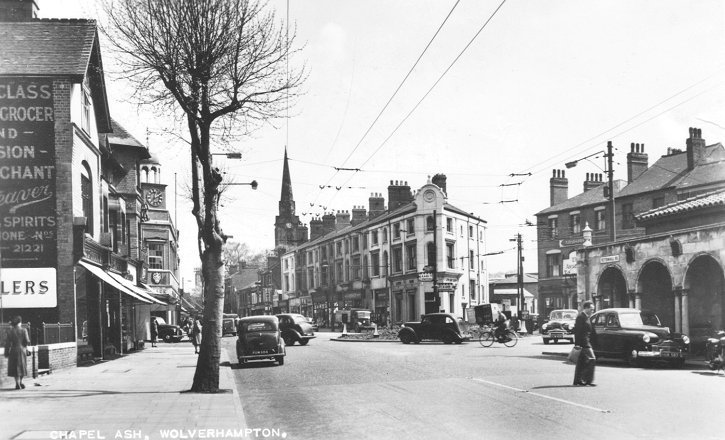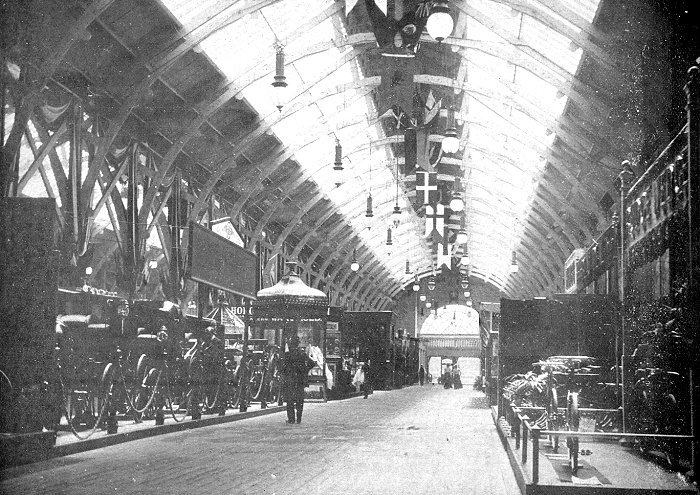|
The name Clark has long graced the Chapel Ash
area. They were first based in the corner plot where a
kitchen and bedroom showroom now stands.

An advert from the 1861 edition of
Harrison, Harrod & Company's Directory & Gazetteer of
Staffordshire.
In J. G. Harrod & Company's postal and commercial
directory of 1870 the business is listed as: William Clark,
carriage builder and harness manufacturer, Chapel Ash.

A view from Merridale Road
looking towards Chapel Ash in about 1900,
clearly showing the early premises. From an old
postcard. |
|

An image from the
early 20th century showing a weathervane above
the ball on the roof. From an old postcard. |
The family coachbuilding business started out in
Walsall. An obituary for Charles Clark in The Chronicle
dated 11th January, 1911 states that this was in 1843
by Charles. Charles was only 6 years old at this time
and the business was actually founded by his father William.
William Clark was born in Stourbridge in 1817. I don’t have
a marriage certificate for him but he was just 20 years old
when his first son, Charles was born in Stourbridge. The
family definitely moved to Walsall sometime between 1837
when the first child Charles was born in Stourbridge and the
birth of the second son John in Walsall in 1847. The date
1843 cited in The Chronicle could therefore be accurate for
the founding of the business. It still made William very
young to be establishing his own business (26 years old) and
I would like to research further back into the family
history as my guess is that William’s father was also a
coachbuilder.
The obituary states that the business moved to
Wolverhampton sometime around 1846. I believe it was
sometime later though, as in 1850 his daughter Ann was born
in Walsall. I have consistently noted during my research
into my family history that men generally moved their family
near their place of work. I therefore conclude that the move
took place sometime between the birth of Ann in Walsall in
1850 and the birth of his son Edward (my great
grandfather) in 1853 at Tettenhall. That’s quite a small
window really.
Our next documentation is from 1861 when we
find Williams’s eldest son Charles, living on Compton Road with his wife Mary and two children (aged 1
year and 3 weeks) where he is described as a
coachbuilder. He was likely working for his father from
a young age.
In 1871, William died aged 54. I think that
he was still head of the company when he died as the
1871 census states that Susan Clark was the widow of a
coachbuilder who employed 24 men.
At this time Charles was 35 years old, John was
24(who was a coachbuilder living with his Mum at Chapel
Ash along with his wife and child) and Edward was 18
years old and also listed as a coachbuilder living
with Mum.
Would the sons be listed as employees? At this
time then we had three coachbuilding brothers, Charles,
John and my Great Grandfather Edward.
A census of 1881 finds Charles living at 34
Chapel Ash with 5 of his 7 children. Charles is
described as Coachbuilder Master employing 19 men and 1
boy. Is he head of the company over John and Edward?
Very possibly as the eldest boy.
| From the 1881 Census: Charles Clark, age 44, born in Stourbridge, a coach
builder master employing 19 men and 1 boy.
Mary D. Clark, wife, age 45, born in Romsey, Hampshire.
Edgar D. Clark, son, age 15, scholar, born in Wolverhampton.
Minnie Clark, daughter, age 13, scholar, born in
Wolverhampton.
Mary L. Clark, daughter, age 11, scholar, born in
Wolverhampton.
Julia M. Clark, daughter, age 9, scholar, born in
Wolverhampton.
Edwin Clark, son, age 7, scholar, born in Wolverhampton.
Lydia Dolton, domestic servant, age 29, born in Terweston,
Buchingham.
|
|

A photo from before 1920
with the florist John E. Knight occupying the
downstairs showroom.
He
also had a shop in the Central Arcade. A
balustrade had been fitted on the roof line.
The A.J.S. motorcycles outside Cyril Williams' motorcycle
shop are from just after the First World War. From an old postcard. |
|

Looking towards the
showroom and Chapel Ash. From an old
postcard. |
The
photograph above was taken when the business was
already in its 70th year and the founder,
William long gone. The downstairs showrooms were
occupied by a florist called Knight and the name on the
building is simply ‘Clark’s Carriage and Motor works’. At the rear of the premises are workshops. As a
signpost on the building says ‘Garage’ and points around
the building, it seems that the rear workshops belonged
to the Clarks.
According to the catalogue, Clarks exhibited in the
Industrial Hall, at West Park in the 1902 Art and
Industrial Exhibition. At the time of the
exhibition, Charles was 65 years old, John 55 years old
and Edward 49 (with his daughter, my Grandmother, Millie,
on the way). Therefore in 1902, the emphasis was still
on carriages.

The interior of the
Industrial Hall showing Clark's display,
consisting of
a selection of carriages including Broughams
and Victorias, and a four-wheeled dog cart.
From Hildreth & Chambers souvenir of the
exhibition. |
A supplement in the Express and Star said that in
1907, Charles' son Edgar was head of the business. Charles Clark's obituary in the Wolverhampton Chronicle
on 11th January, 1911, states that he died at home (35
Chapel Ash) on Sunday 8th January, 1911.
We see from the photographs that selling
cars and building coaches was at least for some time
carried out at the same premises. However, my father
(Edward Clark’s grandson) recalls being told that the
brothers decided to go in two different directions. Charles wanted to focus on cars and Edward wanted to
continue building coaches. There is no reason to
believe that this was anything but amicable. It seems
that Charles wanted to move into selling cars and Edward
wished to continue building coaches.
When did Edward leave the company and
where did Edward build his coaches ?
At some point between his second marriage to Sarah
Ann in 1896 and the birth of his daughter Millicent in
1902, Edward moved from 27, Chapel Ash to 163 Lord
Street. I walked Lord Street to find an approximate
location of their home. The only original buildings in
the street were at the town end. I came across a garage
and went in to make enquiries. Apparently, the building
I had walked into was originally built as coachworks. I
wondered if this was my Great
Grandfather’s ‘lost’ workshop.
| From the 1881 Census: Edward Clark, age 27, born in Stafford, coachbuilder.
Radianetta Clark, wife, age 26, born in Sunderland, Durham.
Beatrice Clark, daughter, age 4, born in Tettenhall. |
|
A little bit about Edward Clark my Great Grandfather
Edward was born on 31st January, 1853 when the
family were living on Tettenhall Road. His father died in 1871 and the census for that
year places Edward with his mother at Chapel Ash,
Wolverhampton.
On the 2nd March, 1875 he married Radianetta,
daughter of Thomas Parkin. Edward was a coach builder,
like his father. When he married he was 22 years old
and Radianetta was 21. The certificate said that they
married at Tettenhall Parish Church. I believe this to
be St. Michael’s. When they married, both Edward and Radianetta were living in Tettenhall, although no
address was given on the marriage certificate. It’s hard
to make out but the signature of one of the witnesses of
their marriage seems to say Anne Elizabeth Clark (could
this be Ann, Edward’s big sister?)
Edward and Radianetta had a little girl called
Beatrice in 1876 and in the census for 1881 we find the
family living in Old Hill, Tettenhall, but unfortunately
no number. From this document we learn that Radianetta
was born in Sunderland, Durham. We have no record of
when she moved to Wolverhampton.
There we lose track of Radianetta and I am forced
to the sad conclusion that this young husband was
bereaved because on 2nd November, 1896 he
married Sarah Ann Wallace. His marriage certificate
says he was 40 years old but according to his birth
certificate, he was 43. Sarah Ann was 34 years old and
had a 13 year old son, Robert. Beatrice would have been
20 years old.
Edward Clark's daughter Millicent was born on 29th
October, 1902 at the family's home, 163 Lord Street,
Wolverhampton.
Edward died in 1920 when he was 67 years old, his
daughter Millie (my Grandmother) being 18 years old. Dad’s (Arthur Edward Porter, Grandson of Edward) notes
say that he died of Tuberculosis but I don’t know how he
knows this. Also that both Edward and Charles are both
buried at Jeffcock Road Cemetery, yet to be confirmed.
|